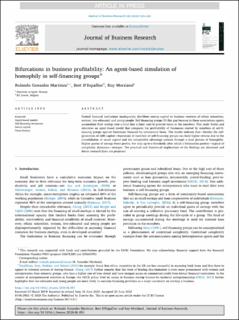Bifurcations in business profitability : An agent-based simulation of homophily in self-financing groups
Journal article, Peer reviewed
Published version
Permanent lenke
https://hdl.handle.net/11250/2733560Utgivelsesdato
2020Metadata
Vis full innførselSamlinger
Originalversjon
Martinez, R. G., D'Espallier, B. & Mersland, R. (2020). Bifurcations in business profitability : An agent-based simulation of homophily in self-financing groups. Journal of Business Research. doi: 10.1016/j.jbusres.2020.06.051Sammendrag
Formal financial institutions inadequately distribute startup capital to business ventures of ethnic minorities, women, low-educated, and young people. Self-financing groups fill this gap because in these associations agents accumulate their savings into a fund that is later used to provide loans to the members. This study builds and simulates an agent-based model that compares the profitability of businesses started by members of self-financing groups against businesses financed by commercial loans. The results indicate that—besides the selfgeneration of debt capital—businesses of members of self-financing groups can have higher returns due to the consolidation of social capital and the competitive advantage created through a dual process of homophily. Higher quotas of savings boost profits, but only up to a threshold, after which a bifurcation pattern—typical of complexity dynamics—emerges. The practical and theoretical implications of the findings are discussed and future research lines are proposed.

